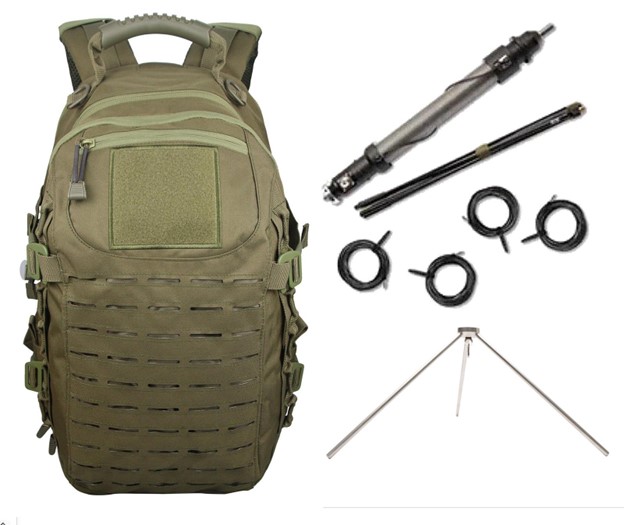In the field, you want a portable ham radio antenna that’s simple to set up and dismantle while providing good performance. Many hams opt for vertical antennas featuring base-loaded whips. They’re readily available and have a wide variety of features with prices all over the map.
The primary advantages of vertical antennas include compact size, relatively light weight, and not needing a lot of space for setup. Signals are omnidirectional and with a sufficient amount of radials can yield a low radiation angle for DX contacts.
But there are so many choices. Which one offers the best combination of features and performance?
Solid Choice
The REZ Antenna Ranger 80 HF is a base-loaded vertical designed for portability and rapid deployment. Because of its build quality and reliability, the Ranger 80 is well suited for portable and EmComm operations. There’s no more fumbling around with tangled radial wire connections—just plug in and get on the air.

Starting from the bottom up, there’s a 17-inch stainless steel spike that accepts 3/8-24 threaded mounting hardware. The Ranger 80’s coil attaches to the spike and will fine tune from 80 meters to 15 meters using the included heavy-duty folding military whip.
The 9.3-foot whip sets up quickly and collapses to a compact 17 inches for transport. A rapid-deploy radial system uses a custom radial “puck” that accepts up to eight 4mm banana plugs. This lets you quickly attach the included four-wire radial kit and leaves room to expand your radial field for better performance.
A MOLLE backpack has numerous pockets and compartments to stash the antenna parts. It also has room for coax, small transceivers, and other necessities. It keeps things organized and makes your portable station instantly ready for deployment, whether it’s a POTA activation or an EmComm exercise. When you’re done making QSOs, the entire system packs neatly and is ready for the next event.
Precision-machined in the USA from premium materials, the Ranger 80 is solidly built, with considerable attention to detail. One available option is a light-duty 10-foot telescoping whip to expand coverage through 10 meters without using the coil. A special ZPOD aluminum tripod and tie-down loop keeps the mount stable in windy, sandy, or rocky locations using a weight.
Using the Ranger 80 at Winter Field Day
It felt a bit weird putting on sunscreen for this winter event. The temperature in western Arizona was near 70 degrees F and it seemed more like summer Field Day.
We set up the Ranger 80 antenna on 40m and added the four radials. I highly recommend that you use an antenna analyzer rather than the noise method of tuning mentioned in the instructions. This method requires finding an empty frequency on your radio and using the noise floor to tune the antenna. It will get you close enough, but you’ll probably want to fine tune it for the best transmit and receive efficiency.
Step away from the antenna each time you make adjustments (about 10 feet) and view the results on your analyzer. Unlike similar verticals that require you to slide and tighten the tuning collar against the coil, the Ranger 80 moves one or several clicks at a time and locks in place automatically. To fine tune, spin the tuning collar either clockwise or counterclockwise. This will cause the tuning collar contact to follow the groove between each wire like a screw thread.
Note that most of the settings are closer to the top and frequencies above 40m will be fairly close together. If you look at the coil position in the picture below, you’ll see that the 40m setting we found was just a few inches from the top.

After a quick touch-up tune on the Icom IC-7300, we found and answered several calls. Then we set up shop on another frequency. Transmit was what you would expect for a base-loaded vertical, and it received better than I expected—with the exception of some interference from nearby ATVs.
Tight Spaces
The spike and ZPOD have a small footprint for POTA activations without imposing a significant impact on the park. Some parks prohibit wires or ropes from being put into trees or stakes in the ground. Vertical antennas may be more acceptable to the park staff and will likely save setup time.
Sometimes limited space makes radials a bit more challenging. As with the DX Commander vertical that I reviewed in an earlier OAB article, adding a number of short radials will provide good performance and require less space. Eight 16-foot radials will work nearly as well as four longer ones, and you can group several together on a single banana plug for easier deployment.

At 9.3 feet, the radiator is considerably less than a quarter wavelength on 80 meters. You will make contacts on 80/40 meters using the coil, but your best results will be on the higher bands where it’s more efficient.
Worth It?
The Ranger 80 is in a class of premium antennas like the Chameleon MPAS 2.0, Deluxe Buddipole, and Super Antenna—all of which share a similar price point. It’s also mechanically superior to a popular vertical that uses a similar loading coil configuration.
Sure, there are dozens of base-loaded verticals available. If you’re looking to upgrade your portable antenna system and appreciate quality materials, rugged construction, and convenience, this could be the antenna for you. It’s a bit like choosing a car–an Equinox will get you there, but an Escalade will do it with style.
Specifications
- Power Handling: 200W SBB, 100W Digital (50% duty cycle)
- Physical Size: 21 inches long/Maximum diameter of 2.25 inches
- Coil Wire: 14ga solid stainless steel wire
- Coil Form Construction: CNC-machined Delrin and black anodized 6061 aluminum
- Hardware: All stainless steel
- Coax Connection: UHF SO-239

